Bishop Matthew W. Clair, Sr. Historical Marker
Introduction
Text-to-speech Audio
This historical marker commemorates the life of Bishop Matthew W. Clair, Sr., one of the first African American ministers to be elected to the bishopric within the Methodist Church. Clair was born in Union, West Virginia in 1865, and became an influential member of the Ames Methodist Episcopal Church which was established in 1857. Bishop Matthew Clair’s ministry spanned many years in West Virginia, Virginia, Washington D.C., Kentucky, Tennessee, Georgia, and the nation of Liberia. Clair returned often to preach in his home church until his death in 1943. Today, the historic church is owned and maintained by the Monroe County West Virginia Historical Society. The restored African American church, known as Ames Clair Hall, is used for community gatherings, meetings, and concerts. A West Virginia historical marker, honoring Bishop Clair was erected in 1979 at Ames Clair Hall.
Images
Historical marker - Union, West Virginia Bishop Matthew W. Clair, Sr. in front of former Ames Methodist Church (Ames Clair Hall)
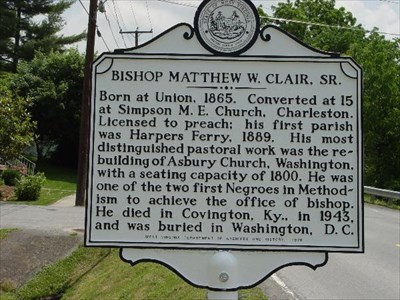
Bishop Matthew W. Clair, Sr 1865-1943 one of the first African American bishops of Methodism
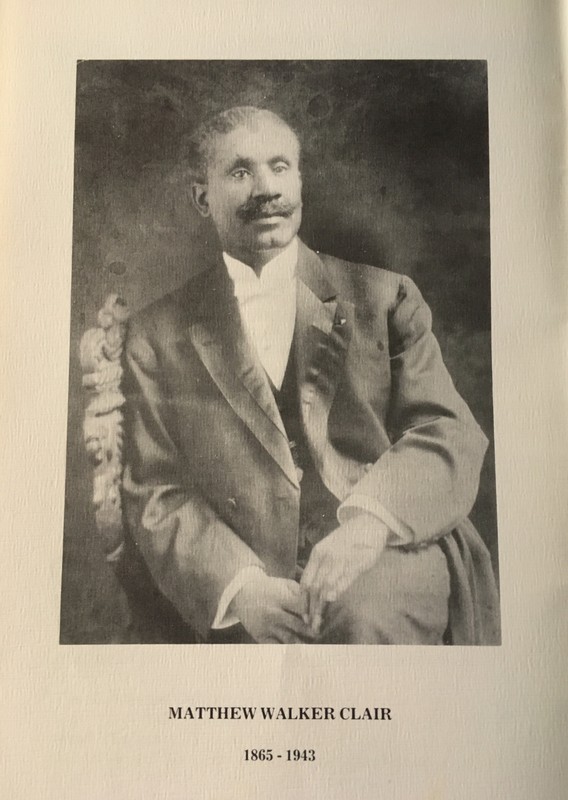
Asbury United Methodist Church, Washington DC; a significant pastoral assignment of Bishop Matthew Clair
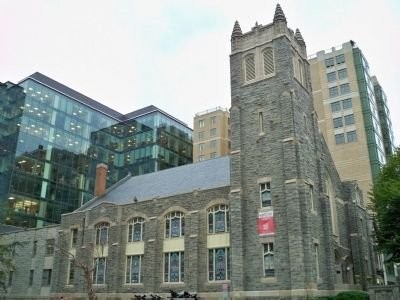
Ames Methodist Church (Ames Clair Hall), Union WV home church of Bishop Matthew W. Clair, Sr.
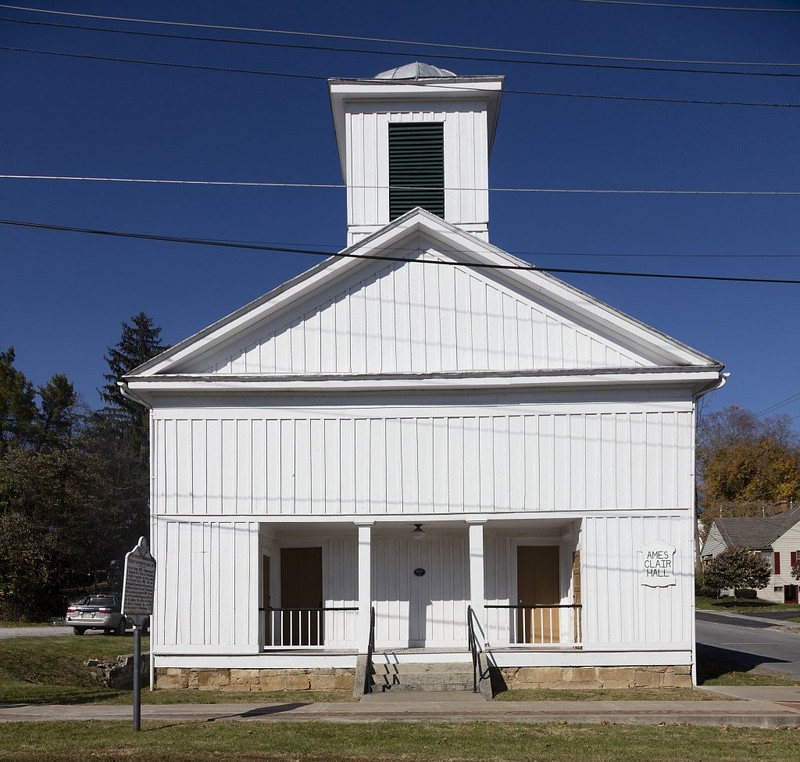
Simpson Memorial United Methodist Church, Charleston WV Bishop Matthew W. Clair, Sr. - Local Preacher's License, 1880-1884
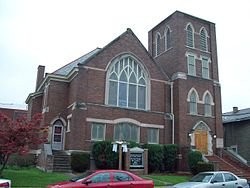
Backstory and Context
Text-to-speech Audio
Matthew Walker Clair was born in Union, West Virginia in 1865, the son of Anthony Clair and Ollie Green Clair, descendants of slaves from the West Coast of Africa. His parents lived and worked as indentured servants. Matt Clair (as he was known in his boyhood) worked on the farms and plantations around Union. The first educational training he received was from his mother and some other women who helped young Matt with his eagerness to learn. At an early age, he became interested in reading the Bible. His family took notice of this, encouraged him and was able to get him enrolled in a Bible Institute in Baltimore, Maryland. During his teen years, he worked to pay for his schooling. Matt lived and worked for some time in Charleston, West Virginia where at the age of fifteen he made a public profession of faith in Christ at Simpson Methodist Episcopal Church. He was later granted a Local Preacher’s License in 1880 at the Simpson M.E. Church. Matthew W. Clair graduated from Morgan College in 1885, later completing his theology studies in 1889. Howard University conferred a Doctor of Divinity degree on Rev. Matthew W. Clair, Sr. in 1911, and he was later conferred a D.D. from his alma mater, Morgan College.
Ames Methodist Episcopal Church was established in 1857 as a second Methodist church in Union, West Virginia. Ames Methodist Episcopal Church was named after Bishop Edward Raymond Ames, elected to the Episcopacy of the Methodist Episcopal Church by the 1852 General Conference. Edward Ames was a firm supporter of the Union during the American Civil War. In 1890 the white congregation of Methodists offered to sell the Ames Church property to an African American congregation, known as the "Joppa" congregation. The Joppa congregation had been meeting in an old dwelling known as the Graham property in Union. The white congregation had become dissatisfied with the old Ames Church location. The property was deeded to the African American congregation on January 29, 1891. The African American congregation continued to worship in the building known as Ames Methodist Episcopal Church until 1990 when it was discontinued as a Methodist congregation. The property was deeded to the Monroe County Historical Society shortly thereafter and the Historical Society restored the old building. The restored structure was given the name Ames Clair Hall to also honor Matthew Clair, Sr. who grew up in the Ames Methodist Episcopal Church. The “Bishop Matthew W. Clair, Sr.” historical marker was erected in 1979 by the West Virginia Department of Archives and History in Union, West Virginia, in Monroe County. It is located in front of the former Ames Methodist Episcopal Church, now restored and named Ames Clair Hall. The Ames Clair Hall is owned and maintained by the Monroe County Historical Society. It is a place for community gatherings, meetings, and concerts.
During his boyhood, Matt Clair was a part of the life of the African American congregation that became the Ames Church, along with his mother. After his public profession of faith at Simpson Methodist Episcopal Church in Charleston and his answer to a call to serve in the ministry he became a gifted preacher. His first church assignment was at Harper’s Ferry, West Virginia in 1889 when he was ordained an Elder in the Methodist Episcopal Church. For the next several years he served churches in Staunton, Virginia and Washington, D.C. He served as “Presiding Elder” or District Superintendent in Washington D.C. in two different appointments by his Methodist bishop. Dr. Margaret B. Ballard writes in a biography of Matthew W. Clair, Sr. – “When Matthew Clair would visit his home in Union he was always asked to preach in Ames Methodist Church. . .The words were spoken distinctly and flowed from his tongue without any hesitation. . .It is said that when he served the bread and wine at a Communion Service, he would frequently break into song as he passed along the chancel.”
At the General Conference of The Methodist Episcopal Church, held in Des Moines, Iowa in 1920, Rev. Matthew W. Clair was elected a bishop along with Rev. Robert E. Jones. Both Clair and Jones were the first African American bishops elected to serve in The Methodist Episcopal Church in the United States. Bishop Matthew Clair’s first assignment after being elected was in Liberia, Africa. After four years he as assigned to the Covington, Kentucky Area which covered fourteen states and Liberia. Liberia was removed from his jurisdiction in 1929. Bishop Clair retired in 1939 at the General Conference in Kansas City, Missouri which united three historical Methodist denominations – The Methodist Episcopal Church, The Methodist Episcopal Church South, and The Methodist Protestant Church forming The Methodist Church. In his retirement, Bishop Matthew Clair was called upon to serve for one year in the Atlanta, Georgia Area of The Methodist Church.
Matthew W. Clair, Sr. died in Washington, D.C. on June 28, 1943. He was first buried in the Old Harmony Cemetery in Washington. A new highway was constructed through the city and the bodies in Old Harmony were removed and relocated to New Harmony Cemetery near Landover, Maryland. The gravesite of Bishop Matthew W. Clair, Sr. is located in Harmony Memorial Park, 7101 Sheriff Road, Landover, Maryland.
Sources
Ballard, Margaret B. Bishop Matthew W. Clair, A Biography. Buckhannon, WV. Commission on Archives & History, UMC, 1973. in conjunction with Monroe County Historical Society
Burrows, Carl E.. Mahoney, David F.. Melting Times, A History of West Virginia United Methodism. Edition Bicentennial. Missouri. Walsworth Publishing, 1984. Commission on Archives & History, W.Va. Conference, The United Methodist Church
Travel Monroe. Accessed September 2017. http://www.travelmonroe.com/attractions.html. travel site for Monroe County, West Virginia
Franklin, Mary Ann. "Foundations of Faith." Greenbrier Valley Quarterly. Greenbrier Valley Quarterly, Summer, 2008.
